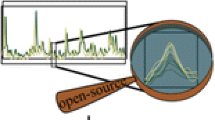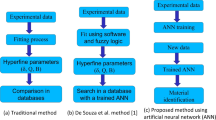Summary
Pyrolysis mass spectrometry (PyMS) was used to produce biochemical fingerprints from replicate frozen cell cultures of mouse macrophage hybridoma 2C11-12, human leukaemia K562, baby hamster kidney BHK 21/C13, and mouse tumour BW-O, and a fresh culture of Chinese hamster ovary CHO cells. The dimensionality of these data was reduced by the unsupervised feature extraction pattern recognition technique of auto-associative neural networks. The clusters observed were compared with the groups obtained from the more conventional statistical approaches of hierarchical cluster analysis. It was observed that frozen and fresh cell line cultures gave very different pyrolysis mass spectra. When only the frozen animal cells were analysed by PyMS, auto-associative artificial neural networks (ANNs) were employed to discriminate between them successfully. Furthermore, very similar classifications were observed when the same spectral data were analysed using hierarchical cluster analysis. We demonstrate that this approach can detect the contamination of cell lines with low numbers of bacteria and fungi; this approach could plausibly be extended for the rapid detection of mycoplasma infection in animal cell lines. The major advantages that PyMS offers over more conventional methods used to type cell lines and to screen for microbial infection, such as DNA fingerprinting, are its speed, sensitivity and the ability to analyse hundreds of samples per day. We conclude that the combination of PyMS and ANNs can provide a rapid and accurate discriminatory technique for the authentication of animal cell line cultures.
Similar content being viewed by others
References
Beale R & Jackson T (1990) Neural Computing: An Introduction. Adam Hilger, Bristol.
Causton DR (1987) A Biologist's Advanced Mathematics. Allen and Unwin, London.
Chauvin Y & Rumelhart DE (ed.) (1995) Backpropagation: Theory, Architectures, and Applications. Erlbaum, Hove, UK.
Chun J, Atalan E, Kim SB, Kim HJ, Hamid ME, Trujillo ME, Magee JG, Manfio GP, Ward AC & Goodfellow M (1993) Rapid identification of Streptomycetes by artificial neural network analysis of pyrolysis mass spectra, FEMS Microbiol Lett 114: 115–119.
De Baetselier P, Brys L, Vercauteren E, Mussche L, Hamers R & Schram E (1984a) Generation of macrophage-hybridomas for the study of macrophage chemiluminescence In: Analytical Application of Bioluminescence and Chemiluminescence. Academic Press, New York.
De Baetselier P, Roos E, Brys L, Remels L & Feldman M (1984b) Generation of invasive and metastatic variants of a non-metastatic T-cell lymphoma by in vivo fusion with normal host cells, Int J Cancer 34: 731–738.
Dussurget O, Henry A, Lemercier B & Roullanddussoix D (1994) Polymerase chain reaction based diagnosis of mollicute infection of commercial animal sera, J Microbiol Meth 20: 125–135.
Everitt BS (1993) Cluster Analysis. Edward Arnold, London.
Flores EF & Donis RO (1995) Isolation of a mutant MDBK cell line resistant to bovine viral diarrhea virus infection due to a block in viral entry, Virology 208: 565–575.
Flury B & Riedwyl H (1988) Multivariate Statistics: A Practical Approach. Chapman and Hall, London.
Freeman R, Goodacre R, Sisson PR, Magee JG, Ward AC & Lightfoot NF (1994) Rapid identification of species within the Mycobacterium tuberculosis complex by artificial neural network analysis of pyrolysis mass spectra, J Med Microbiol 40: 170–173.
Goodacre R (1994) Characterisation and quantification of microbial systems using pyrolysis mass spectrometry: Introducing neural networks to analytical pyrolysis, Microbiol Eur 2: 16–22.
Goodacre R & Berkeley RCW (1990) Detection of small genotypic changes in Escherichia coli by pyrolysis mass spectrometry, FEMS Microbiol Lett 71: 133–137.
Goodacre R, Hiom SJ, Cheeseman SL, Murdoch D, Weightman AJ & Wade WG (1996a) Identification and discrimination of oral asaccharolytic Eubacterium spp. using pyrolysis mass spectrometry and artificial neural networks, Cur Microbiol 32: 77–84.
Goodacre R, Howell SA, Noble WC & Neal MJ (1996b) Subspecies discrimination using pyrolysis mass spectrometry and self-organising neural networks of Propionibacterium acnes isolated from normal human skin, Zbl Bakt: in the press.
Goodacre R & Kell DB (1995) Composition analysis, UK Patent #9511619.0 of June 8th, 1995.
Goodacre R & Kell DB (1996a) Pyrolysis mass spectrometry and its applications in biotechnology, Cur Opin Biotechnol 7: 20–28.
Goodacre R & Kell DB (1996b) Correction of mass spectral drift using artificial neural networks, Anal Chem 68: 271–280.
Goodacre R, Kell DB & Bianchi G (1992) Neural networks and olive oil, Nature 359: 594–594.
Goodacre R, Kell DB & Bianchi G (1993) Rapid assessment of the adulteration of virgin olive oils by other seed oils using pyrolysis mass spectrometry and artificial neural networks, J Sci Food Agric 63: 297–307.
Goodacre R, Neal MJ & Kell DB (1994a) Rapid and quantitative analysis of the pyrolysis mass spectra of complex binary and tertiary mixtures using multivariate calibration and artificial neural networks, Anal Chem 66: 1070–1085.
Goodacre R, Neal MJ & Kell DB (1996c) Quantitative analysis of multivariate data using artificial neural networks: a tutorial review and applications to the deconvolution of pyrolysis mass spectra, Zbl Bakt: in the press.
Goodacre R, Neal MJ, Kell DB, Greenham LW, Noble WC & Harvey RG (1994b) Rapid identification using pyrolysis mass spectrometry and artificial neural networks of Propionibacterium acnes isolated from dogs, J App Bacteriol 76: 124–134.
Goodacre R, Pygall J & Kell DB (1996d) Plant seed classification using pyrolysis mass spectrometry with unsupervised learning; the application of auto-associative and Kohonen artificial neural networks, Chemometr Intell Lab Sys 34: 69–83.
Goodacre R, Trew S, Wrigley-Jones C, Saunders G, Neal MJ, Porter N & Kell DB (1995) Rapid and quantitative analysis of metabolites in fermentor broths using pyrolysis mass spectrometry with supervised learning: application to the screening of Penicillium chrysogenum fermentations for the overproduction of penicillins, Anal Chim Acta 313: 25–43.
Goodfellow M (1995) Inter-strain comparison of pathogenic microorganisms by pyrolysis mass spectrometry, Binary-Comp Microbiol 7: 54–60.
Gower JC (1971) A general coefficient of similarity and some of its properties, Biomet 27: 857–874.
Gutteridge CS, Vallis L & MacFie HJH (1985) Numerical methods in the classification of microorganisms by pyrolysis mass spectrometry. In: Goodfellow M, Jones D & Priest F (ed.) Computer-assisted Bacterial Systematics. (pp. 369–401) Academic Press, London.
Hay RJ (1988) The seed stock concept and quality control for cell lines, Analytical Biochemistry 171: 225–237.
Haykin S (1994) Neural Networks. Macmillan, New York.
Hecht-Nielsen R (1990) Neurocomputing. Addison-Wesley, Massachusetts.
Hertz J, Krogh A & Palmer RG (1991) Introduction to the Theory of Neural Computation. Addison-Wesley, California.
Hopert A, Uphoff CC, Wirth M, Hauser H & Drexler HG (1993a) Mycoplasma detection by PCR analysis, In Vitro Cellular & Developmental Biology—Animal 29A: 819–821.
Hopert A, Uphoff CC, Wirth M, Hauser H & Drexler HG (1993b) Specificity and sensitivity of polymerase chain reaction (PCR) in comparison with other methods for the detection of mycoplasma contamination in cell lines, J Immunol Meth 164: 91–100.
Irwin WJ (1982) Analytical Pyrolysis: A Comprehensive Guide. Marcel Dekker, New York.
Jacobsson SP (1994) Feature extraction of polysaccharides by lowdimensional internal representation neural networks and infrared spectroscopy, Anal Chim Acta 291: 19–27.
Jolliffe IT (1986) Principal Component Analysis. Springer-Verlag, New York.
Kohonen T (1989) Self-Organization and Associative Memory. Springer-Verlag, Berlin.
Kramer MA (1991) Non linear principal components analysis using auto-associative neural networks, AIChE J 37: 233–243.
Kramer MA (1992) Autoassociative neural networks, Comput Chem Eng 16: 313–328.
Kuespert DR & McAvoy TJ (1994) Knowledge extraction in chemical process control, Chem Eng Comm 130: 251–264.
Leonard JA & Kramer MA (1993) Diagnosing dynamic faults using modular neural nets, IEEE Expert 8: 44–53.
MacFie HJH, Gutteridge CS & Norris JR (1978) Use of canonical variates in differentiation of bacteria by pyrolysis gas-liquid chromatography, J Gen Microbiol 104: 67–74.
Magee JT (1993) Whole-organism fingerprinting. In: Goodfellow M & O'Donnell AG (ed.) Handbook of New Bacterial Systematics. (pp. 383–427) Academic Press, London.
Martens H & Næs T (1989) Multivariate Calibration. John Wiley and Sons, New York.
Meuzelaar HLC, Haverkamp J & Hileman FD (1982) Pyrolysis Mass Spectrometry of Recent and Fossil Biomaterials. Elsevier, Amsterdam.
Montague G & Morris J (1994) Neural network contributions in biotechnology, Trends Biotechnol 12: 312–324.
Mowles JM & Doyle A (1990) Cell culture standards—time for a rethink, Cytotechnology 3: 107–108.
Nelder JA (1979) Genstat Reference Manual. Scientific and Social Service Program Library, University of Edinburgh.
Nicklas W, Kraft V & Meyer B (1993) Contamination of transplantable tumors, cell lines, and monoclonal antibodies with rodent viruses, Lab Animal Sci 43: 296–300.
Park JG, Lee JH, Kang MS, Park KJ, Jeon YM, Lee HJ, Kwon HS, Park HS, Yeo KS, Lee KU, Kim ST, Chung JK, Hwang YJ, Lee HS, Kim CY, Lee YI, Chen TR, Hay RJ, Song SY, Kim WH, Kim CW & Kim YI (1995) Characterization of cell lines established from human hepatocellular carcinoma, Int J Cancer 62: 276–282.
Ripley BD (1994) Neural networks and related methods for classification, J Roy Stats Soc Series B-Methodological 56: 409–437.
Rumelhart DE, McClelland JL & The PDP Research Group (1986) Parallel Distributed Processing, Experiments in the Microstructure of Cognition. MIT Press, Cambridge, Mass.
Simpson PK (1990) Artificial Neural Systems. Pergamon Press, Oxford.
Sisson PR, Freeman R, Law D, Ward AC & Lightfoot NF (1995) Rapid detection of verocytotoxin production status in Escherichia coli by artificial neural network analysis of pyrolysis mass spectra, J Anal Appl Pyrol 32: 179–185.
Snyder AP, Smith PBW, Dworzanski JP & Meuzelaar HLC (1994) Pyrolysis-gas chromatography-mass spectrometry-detection of biological warfare agents, ACS Symp Ser 541: 62–84.
Stacey GN, Bolton BJ & Doyle A (1992a) DNA fingerprinting transforms the art of cell authentication, Nature 357: 261–262.
Stacey GN, Bolton BJ, Morgan D, Clark SA & Doyle A (1992b) Multilocus DNA fingerprint analysis of cellbanks—stability studies and culture identification in human B-lymphoblastoid and mammalian cell lines, Cytotechnology 8: 13–20.
Steube KG, Grunicke D & Drexler HG (1995) Isoenzyme analysis as a rapid method for the examination of the species identity of cell cultures, In Vitro Cellular & Developmental Biology—Animal 31: 115–119.
Uphoff CC, Gignac SM & Drexler HG (1992a) Mycoplasma contamination in human leukemia cell lines. 1. Comparison of various detection methods, J Immunol Meth 149: 43–53.
Uphoff CC, Gignac SM & Drexler HG (1992b) Mycoplasma contamination in human leukemia cell lines. 2. Elimination with various antibiotics, J Immunol Meth 149: 55–62.
Wasserman PD (1989) Neural Computing: Theory and Practice. Van Nostrand Reinhold, New York.
Werbos PJ (1994) The Roots of Back-Propagation: From Ordered Derivatives to Neural Networks and Political Forecasting. John Wiley and Sons, Chichester.
Werner RG & Noe W (1993) Mammalian cell cultures. 1. Characterization, morphology and metabolism, Arzneimittel-Forschung/Drug Research 43: 1134–1139.
Werner RG, Walz F, Noe N & Konrad A (1992) Safety and economic aspects of continuous mammalian cell culture, J Biotechnol 22: 51–68.
Windig W, Haverkamp J & Kistemaker PG (1983) Interpretation of sets of pyrolysis mass spectra by discriminant analysis and graphical rotation, Anal Chem 55: 81–88.
Zupan J & Gasteiger J (1993) Neural Networks for Chemists: An Introduction. VCH Verlagsgesellschaft, Weinheim.
Author information
Authors and Affiliations
Rights and permissions
About this article
Cite this article
Goodacre, R., Rischert, D.J., Evans, P.M. et al. Rapid authentication of animal cell lines using pyrolysis mass spectrometry and auto-associative artificial neural networks. Cytotechnology 21, 231–241 (1996). https://doi.org/10.1007/BF00365346
Received:
Accepted:
Issue Date:
DOI: https://doi.org/10.1007/BF00365346




